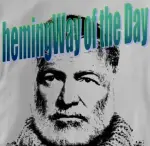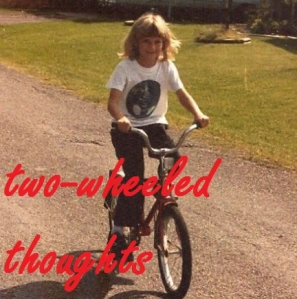Following Friday’s review of A Short Walk Through a Wide World, here’s Douglas Westerbeke: “It Might as Well Be Infinite.”
Douglas Westerbeke is a librarian in Ohio, at one of the largest libraries in the United States. He began writing with screenplays, and has served for the last decade on the local panel of the International Dublin Literary Award. His first novel, A Short Walk Through a Wide World, coming from Avid Reader Press on April 9, 2024, is the dazzling story of a woman who must keep moving to outrun a mysterious curse, and a library that seems tailored perfectly to her.
Did reading for the Dublin Literary Award help you write this novel?

Douglas Westerbeke (photo: Roan Westerbeke)
I was reading 50 to 100 novels a year, and some I loved and found really inspiring, and some of them were awful. I thought: I can do better than that. The more you read, the more story ideas you keep having; it snowballs, I guess. I used to write short stories when I was a little kid. My mom always told me, you should write a novel. I said no, I can’t be a novelist, those are real writers! I can’t be like them. The Dublin Literary Committee opened my eyes. It’s achievable. You could be like one of these guys–mostly gals, actually. That’s what inspired me. I thought, I’ll give it a try. It’s hard. I’m not used to working on prose that hard, at a sentence level. That’s where all the work really is, for me anyway. And structure. This one is particularly hard for structure.
What impact did your screenwriting background have on the novel?
I lived in Los Angeles for a while, writing screenplays and sending them out. I did pretty well–four of them got optioned, but they never got produced. I gave up. Well, I shouldn’t say that, because I kept writing. In fact, the day I was going to give up, I had another story idea, about a guy who tries to give up his life as a musical composer.
I had kids, and that slowed things down, and I had cancer, and that really slowed things down. And then the Dublin Literary put me on a different path. Forget that, I’ll try this. My odds were better. Back there it was like a million to one, and this is like 100,000 to one. I thought, those are pretty good odds!
Where did the idea of Aubry’s illness come from?
This all began as a short story idea. It was kind of a comedy. It was an old lady in the same time period–if you put it in the modern day, everybody would just be hanging out in airports, right? Older days, you get to ride trains and ships. Old lady goes to her doctor and says, I’m feeling arthritic, something small like that, and the doctor says, maybe try traveling. Go somewhere warm and dry. And all she hears is “travel.” She just takes off, and she’s so scared of her ailment, she ends up in these dangerous situations traveling around the world. She’s this doddering old fearful lady–the joke is, the cure is worse than the ailment. But then I kept thinking, how am I going to end it? She’ll be on a cruise ship, and it’ll break down in the ocean, they have to anchor, and in the middle of the night she passes away. She was so concerned that what the doctor said was true that she just passes away. And then all of a sudden I was like, this isn’t a comedy anymore!
I thought, maybe she should uncover some great mystery of the world before she goes. She ended up being a nine-year-old girl instead, because now I have so many ideas, I’m not going to get it all with just this little old lady. It’s got to be a whole lifetime.
You are a librarian whose novel, naturally, involves a very special library.
It’s the best place ever to work. I love working there. And working there, you’re doing your stuff, you’re processing the new books, you’re answering questions, you’re doing research, and all the while some book will be sitting on the corner of the desk, and you’re just looking at it the whole day, and it looks really interesting, but you have so much work to do. That’s the life. But then maybe at the end of the day you’ll have some time to yourself, and you’ll open it up. It’s like a treasure trove. Random stuff. I’ve studied an analysis of Shakespeare, I’ve learned how to invest in the stock market, I’ve compiled hundreds of recipes to cook, all because random books kept coming across my desk. And then you start to realize, I’m not reading even the tiniest fraction of the books in this collection. I will never live long enough to read them all. It might as well be infinite.
I was always struck by the impossibility of all this knowledge no one person could ever get. And we have these libraries all over. I mean, I’m in a pretty big library, but even in a small branch I wouldn’t be able to read it all. The idea of the infinite library, I guess, comes from that. But I’m not the first guy. Borges does this all the time. It’s also a riff on him, I suppose.
You are yourself well-traveled. What kind of research was necessary?
I’ve traveled a bit, but almost nothing in this book happens in places I’ve been. I’ve been close to Thailand, or Siam–I was in Malaysia. Doesn’t count! And I certainly wasn’t there in 1900. The whole world is different now, so you really have to research it in the library anyway.
I read all up on the gold rush, and how all these women got rich up there, and I read all about North Africa and people’s experiences, Westerners who got shipwrecked and tried to make their way across the Sahara… the best book I got, I found up in the storage in our library. It was all about the Indian royalty during colonial Britain, and it had all these photographs.
You have the story first. The research is really useful–it helps add color, detail. If you’re way off on an aspect of the story you can correct it. But for the most part, the story I had when I started was the story I ended up with. You want to be sure you’re not doing any blatant anachronisms or anything. I love Braveheart but there’s no historical accuracy whatsoever. But this novel takes place in a lot of obscure little corners of the world, a century ago. All these places no longer exist. And it’s a fantastical story as well, which gives you a lot of wiggle room. You don’t necessarily have to be a nitpicker when it comes to the research, but it does help you to not mess something totally up. You can describe the Arab woman with the copper coins.
What’s next?
I’m working on another with similar themes to this. It’s tricky because it’s modern-day and the characters are two little kids, and I’m trying to write it in their voice. I’m reading a lot of Emma Donoghue.
This interview originally ran on October 12, 2023 as a Shelf Awareness special issue. To subscribe, click here, and you’ll receive two issues per week of book reviews and other bookish fun.
Filed under: interviews | Tagged: authors, Maximum Shelf, Shelf Awareness | Leave a comment »
















